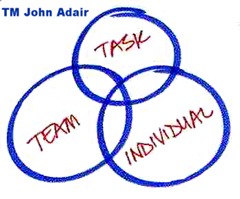
Coaching and Consulting a team, we found ourselves in an ambiguous discussion about the responsibility of a team leader.
I shared John Adair’s action-centered leadership model, and we took some ideas + examples.
When the management team documented the responsibility, they could compare that to the authority of the team leader, and we changed how the work got done, leading to people working differently.
- Achieving the task
- building & maintaining the team
- developing the individual *
What is the team leader’s responsibility in team building?
The first responsibility of the team leader is to define the team’s objective; why is this team together. When the purpose is unclear, unknowable, or complex, framing the boundaries and defining that this team will work to make progress or identify clues that may work to achieve a shared outcome is still setting the teams’ objective.
Once the team understands and accepts the objective, each person will develop trust within the team and team members by knowing the skilled knowledge and role that each team member will occupy. This should be worked out jointly between the leader and the individual concerned.
Team Leader functions in teambuilding
Effective leaders in team building need to provide the functions of:
Boundary setting / Planning
- seeking all available and relevant information
- defining the task, purpose, or goal
- devising a realistic framework for achieving the desired outcome
Initiating
- openly briefing the team on the aims and the plan of action
- explaining why the task is necessary and the reasoning behind the plan
- allocating tasks to team members
- setting group standards
Monitoring
- maintaining the group standards as previously set
- keeping a watch on timing and progress
- ensuring all actions are moving towards desired results
- keeping discussions relevant and on-track
- keeping the group moving and active
Coaching and Supporting
- expressing recognition of individuals contributions
- encouraging the whole group as well as to individuals
- dealing with team / individual dysfunction where necessary and appropriate
- create a team spirit and boosting morale
- watching and dispersing tension between team members
- reconciling disagreements and controlling the exploration of disagreements
Informing
- clarifying the task and the plan as the project makes progress
- sharing new information with the team and keeping them informed of developments
- listening to the group and receiving feedback from them
- discussing ideas and suggestions within the group
Evaluating
- checking the feasibility of ideas
- testing the consequences of new ideas and proposed solutions
- evaluating group performance and giving feedback
- working with the group to evaluate themselves against the standards set
Not all these functions will be necessary all the time, and together they will allow the team leader to:
- achieve the task
- build & maintain the team
- develop the individual
Hire Mike Cardus
Referenced: Thomas, N. (Ed.). (2004). Adair on teambuilding and motivation. London: Thorogood.

